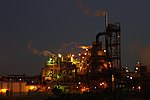Fremantle Outer Harbour
City of KwinanaEast Rockingham, Western AustraliaFremantle Harbour

The Fremantle Outer Harbour is the part of Fremantle Harbour located in the Cockburn Sound, at the City of Kwinana, Western Australia. Fremantle Harbour consists of the Inner Harbour, which is situated on the mouth of the Swan River; and the Outer Harbour, which is 20 km to the south. It is managed by the Fremantle Port Authority. The Outer Harbour's creation dates back to the Stephenson-Hepburn Report and was initiated in 1955.
Excerpt from the Wikipedia article Fremantle Outer Harbour (License: CC BY-SA 3.0, Authors, Images).Fremantle Outer Harbour
Riseley Road, City Of Kwinana
Geographical coordinates (GPS) Address Nearby Places Show on map
Geographical coordinates (GPS)
| Latitude | Longitude |
|---|---|
| N -32.20975 ° | E 115.76822 ° |
Address
Riseley Road
City Of Kwinana, Naval Base
Western Australia, Australia
Open on Google Maps








